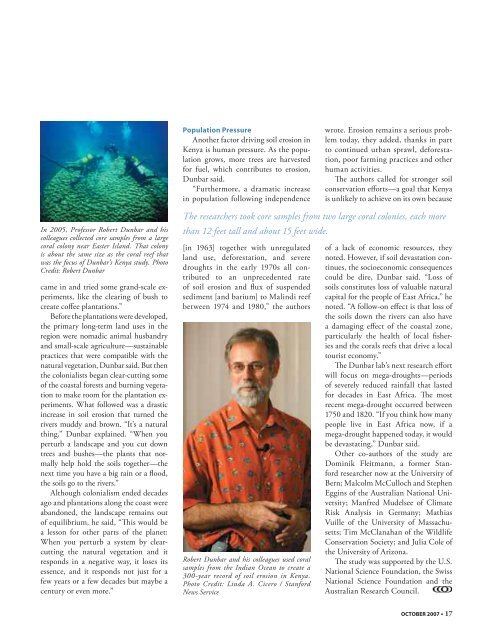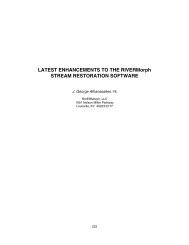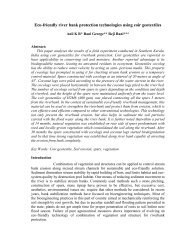ENVIRONMENTAL - International Erosion Control Association
ENVIRONMENTAL - International Erosion Control Association
ENVIRONMENTAL - International Erosion Control Association
Create successful ePaper yourself
Turn your PDF publications into a flip-book with our unique Google optimized e-Paper software.
Population Pressure<br />
Another factor driving soil erosion in<br />
Kenya is human pressure. As the population<br />
grows, more trees are harvested<br />
for fuel, which contributes to erosion,<br />
Dunbar said.<br />
“Furthermore, a dramatic increase<br />
in population following independence<br />
wrote. <strong>Erosion</strong> remains a serious problem<br />
today, they added, thanks in part<br />
to continued urban sprawl, deforestation,<br />
poor farming practices and other<br />
human activities.<br />
The authors called for stronger soil<br />
conservation efforts—a goal that Kenya<br />
is unlikely to achieve on its own because<br />
In 2005, Professor Robert Dunbar and his<br />
colleagues collected core samples from a large<br />
coral colony near Easter Island. That colony<br />
is about the same size as the coral reef that<br />
was the focus of Dunbar’s Kenya study. Photo<br />
Credit: Robert Dunbar<br />
came in and tried some grand-scale experiments,<br />
like the clearing of bush to<br />
create coffee plantations.”<br />
Before the plantations were developed,<br />
the primary long-term land uses in the<br />
region were nomadic animal husbandry<br />
and small-scale agriculture—sustainable<br />
practices that were compatible with the<br />
natural vegetation, Dunbar said. But then<br />
the colonialists began clear-cutting some<br />
of the coastal forests and burning vegetation<br />
to make room for the plantation experiments.<br />
What followed was a drastic<br />
increase in soil erosion that turned the<br />
rivers muddy and brown. “It’s a natural<br />
thing,” Dunbar explained. “When you<br />
perturb a landscape and you cut down<br />
trees and bushes—the plants that normally<br />
help hold the soils together—the<br />
next time you have a big rain or a flood,<br />
the soils go to the rivers.”<br />
Although colonialism ended decades<br />
ago and plantations along the coast were<br />
abandoned, the landscape remains out<br />
of equilibrium, he said, “This would be<br />
a lesson for other parts of the planet:<br />
When you perturb a system by clearcutting<br />
the natural vegetation and it<br />
responds in a negative way, it loses its<br />
essence, and it responds not just for a<br />
few years or a few decades but maybe a<br />
century or even more.”<br />
The researchers took core samples from two large coral colonies, each more<br />
than 12 feet tall and about 15 feet wide.<br />
[in 1963] together with unregulated<br />
land use, deforestation, and severe<br />
droughts in the early 1970s all contributed<br />
to an unprecedented rate<br />
of soil erosion and flux of suspended<br />
sediment [and barium] to Malindi reef<br />
between 1974 and 1980,” the authors<br />
Robert Dunbar and his colleagues used coral<br />
samples from the Indian Ocean to create a<br />
300-year record of soil erosion in Kenya.<br />
Photo Credit: Linda A. Cicero / Stanford<br />
News Service<br />
of a lack of economic resources, they<br />
noted. However, if soil devastation continues,<br />
the socioeconomic consequences<br />
could be dire, Dunbar said. “Loss of<br />
soils constitutes loss of valuable natural<br />
capital for the people of East Africa,” he<br />
noted. “A follow-on effect is that loss of<br />
the soils down the rivers can also have<br />
a damaging effect of the coastal zone,<br />
particularly the health of local fisheries<br />
and the corals reefs that drive a local<br />
tourist economy.”<br />
The Dunbar lab’s next research effort<br />
will focus on mega-droughts—periods<br />
of severely reduced rainfall that lasted<br />
for decades in East Africa. The most<br />
recent mega-drought occurred between<br />
1750 and 1820. “If you think how many<br />
people live in East Africa now, if a<br />
mega-drought happened today, it would<br />
be devastating,” Dunbar said.<br />
Other co-authors of the study are<br />
Dominik Fleitmann, a former Stanford<br />
researcher now at the University of<br />
Bern; Malcolm McCulloch and Stephen<br />
Eggins of the Australian National University;<br />
Manfred Mudelsee of Climate<br />
Risk Analysis in Germany; Mathias<br />
Vuille of the University of Massachusetts;<br />
Tim McClanahan of the Wildlife<br />
Conservation Society; and Julia Cole of<br />
the University of Arizona.<br />
The study was supported by the U.S.<br />
National Science Foundation, the Swiss<br />
National Science Foundation and the<br />
Australian Research Council.<br />
OCTOBER 2007 • 17













